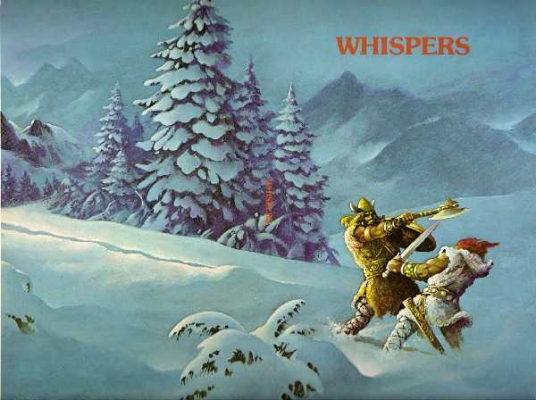The Golden Age of Science Fiction: “The Button Molder,” by Fritz Leiber

In 1972, the British Fantasy Society began giving out the August Derleth Fantasy Awards for best novel as voted on by their members. A Short Fiction/Short Story category was added the next year, with the first one being won in 1973 by L. Sprague de Camp for his novella The Fallible Fiend. In 1976. The name of the awards was changed to the British Fantasy Award, although the August Derleth Award was still the name for the Best Novel Award. The category has remained part of the awards to the present day, although a re-alignment in 2012 means the awards are now selected by a jury rather than the full membership of the British Fantasy Society. In 1980, Fritz Leiber won the award for his story “The Button Molder,” which was presented at Fantasycon VI in Birmingham.
Leiber opens the story by teasing about how much can happen within a ten second period of time and the appearance of a ghost. His character then goes on a lengthy discussion about his living situation in San Francisco as he finds a new apartment and sets himself up as an author and amateur astronomer, working from his building’s roof. With long ruminations on what it means to be an author and techniques of story-telling, the story feels very autobiographical in nature and it is only the occasional hints back to those important ten seconds that remind the reader this is a story and not an essay about Leiber’s life.
The monotony of the character’s daily life is broken up by his glimpses of strange phenomenon…a ray of light, a shadow in his apartment, a bank of strange clouds. In each case, he quickly figures out what they must be, denying any possibility of supernatural or extraterrestrial origin. They are a flagpole, a glimpse of frame caught of out of the corner of his eye, and skywriting seen from a strange angle. Taken together with his various interests and his hints about seeing a ghost, these incidents set up the rationality of the character and his skepticism towards the inexplicable.
When the ghost finally does appear in the story, it is anti-climactic and serves to provide the narrator with further reasons for navel gazing. As the story’s title suggests, the ghost’s purpose in the story is similar to the button molder in Henrik Ibsen’s play Peer Gynt, although that is a reference which will probably be lost on most of the story’s readers, who may be more familiar with Peer Gynt through Edvard Grieg’s incidental music than the play itself. In the play, the button molder confronts Gynt and tells him that his soul must be melted down unless Gynt can explain when and where he has been himself, which in the confines of Leiber’s story merely gives his already reflective character even more reasons to think about who he is and what he does.
“The Button Molder” is a slow-moving, introspective story that builds up a detailed world for its lone, and lonely, character, feeding him opportunities to consider who he is and what he does while he becomes more and more introspective. The sections of the story dealing with his stargazing are the most interesting parts, while the literary considerations seem the most personal. However the story, as a whole, is slow moving and feels like the apparition that appears and the discovery behind it are just tacked on to make the entire tale an exercise in navel-gazing.
Leiber’s competition for the British Fantasy Award for Short Fiction was Adrian Cole’s “First Make Them Mad” and Tanith Lee’s “Red as Blood.”
 Steven H Silver is a sixteen-time Hugo Award nominee and was the publisher of the Hugo-nominated fanzine Argentus as well as the editor and publisher of ISFiC Press for 8 years. He has also edited books for DAW, NESFA Press, and ZNB. He began publishing short fiction in 2008 and his most recently published story is “Webinar: Web Sites” in The Tangled Web. His most recent anthology, Alternate Peace was published in June. Steven has chaired the first Midwest Construction, Windycon three times, and the SFWA Nebula Conference 6 times, as well as serving as the Event Coordinator for SFWA. He was programming chair for Chicon 2000 and Vice Chair of Chicon 7.
Steven H Silver is a sixteen-time Hugo Award nominee and was the publisher of the Hugo-nominated fanzine Argentus as well as the editor and publisher of ISFiC Press for 8 years. He has also edited books for DAW, NESFA Press, and ZNB. He began publishing short fiction in 2008 and his most recently published story is “Webinar: Web Sites” in The Tangled Web. His most recent anthology, Alternate Peace was published in June. Steven has chaired the first Midwest Construction, Windycon three times, and the SFWA Nebula Conference 6 times, as well as serving as the Event Coordinator for SFWA. He was programming chair for Chicon 2000 and Vice Chair of Chicon 7.
Frazetta wants his snow giants back &altText=RnJhemV0dGEgQ2FudmFzIFByaW50IDE2eDIwIC0gVGhlIFNub3cgR2lhbnRz0
&altText=RnJhemV0dGEgQ2FudmFzIFByaW50IDE2eDIwIC0gVGhlIFNub3cgR2lhbnRz0
–
“Frazetta wants his snow giants back.”
Seriously?
Well it’s just a lazy swipe on the artists part….
The painting is a good match for the Leiber story it illustrates, part of the novella RIME ISLE.
I hope there are readers out there who encounter the story for the first time the same way I did; done with the day’s unpacking in a new house, sat down to read through one of the unpacked books, read the story as the shadows grew long and the light turned orange near dusk… (Loved it!)